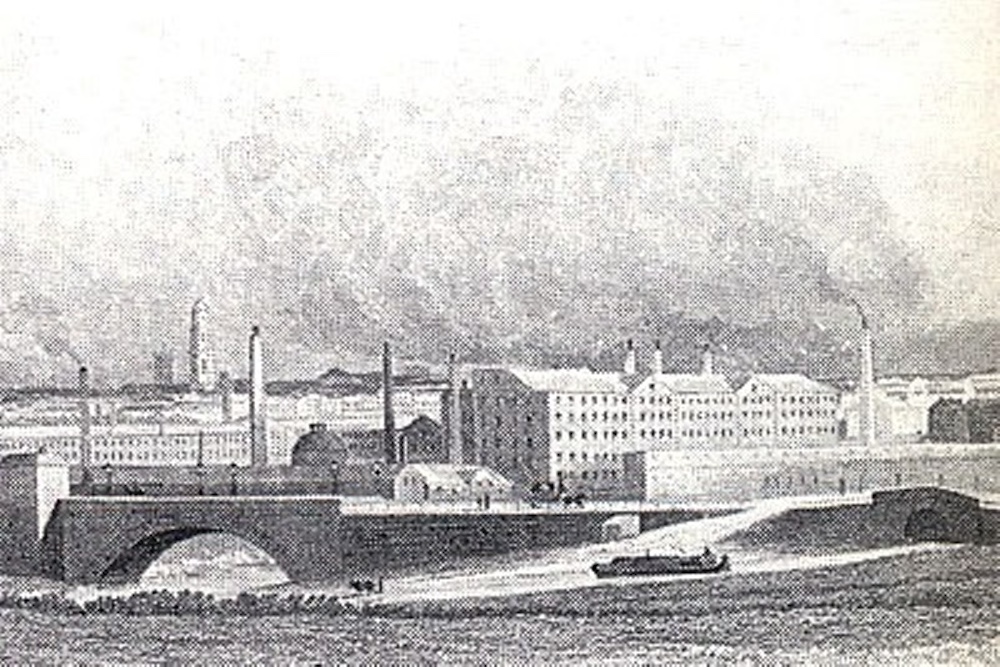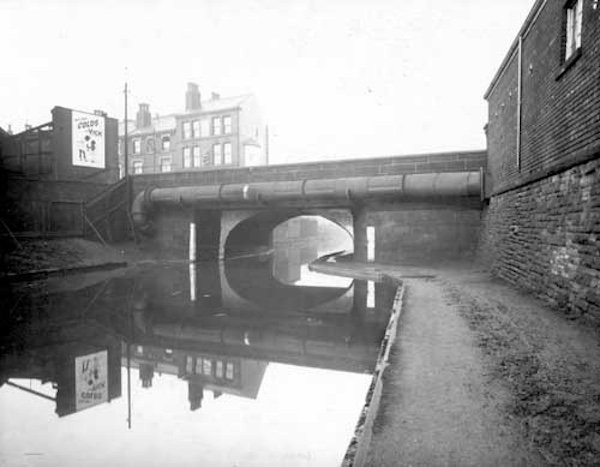
After writing an article previously about Leeds Bridge I began to think of the other bridges that spanned the River Aire and its Navigation as well as the Leeds & Liverpool Canal.
With this in mind I thought why not start at Wellington Bridge and travel downriver towards Hunslet. Leeds Bridge was not a toll bridge but the Wellington, Monk, Victoria, and Crown Point Bridges were all toll bridges.
Originally a wooden footbridge had been erected over the River Aire so that people from Armley and Wortley as well as Holbeck could travel to work at Gott’s Bean Ing Mill and for others going to and from Leeds.
A plan was put forward for two stone bridges, one over the Leeds & Liverpool Canal at Drony Lathe and another which would later become known as Wellington Bridge and this was to be the second crossing by bridge of the River Aire in Leeds. It was built largely by the efforts of one of the main subscribers, Benjamin Gott.
An Application to Parliament was made in April 1817 for the bridge known as the Waterloo Bridge and as there were no problems the Act received Royal Assent on the 16 June of that year.
The Engineer for the bridge was John Rennie (1761-1821) a well known Civil Engineer and the responsibility was given to H Teal a Leeds Engineer for the access roads.
At a meeting on the 6 August 1817 Rennie’s plans and estimates were accepted and approved and on the 26 August contracts were let to Richard Collinson and Isaac Whitaker to build the road and bridges at a cost of £7,000 with the stipulation that the bridge had to be completed by 1 January 1819.
The bridge was built from September 1817 using stone from Bramley Falls Quarry, Leeds, and on the 12 March 1818 Benjamin Gott laid the foundation stone under which was placed a lead case containing a glass vase with gold, silver and copper coins of George III’s reign, a Wellington Medal, Bank of England Tokens and an inscribed silver plate.
The larger bridge over the River Aire consisted of an elliptical arch with a 100 foot span for which the keystone was laid on 10 October of the same year. The second, smaller structure went over the Leeds & Liverpool Canal.
February 1819 saw the bridge substantially complete and on the 19th the Trustees ordered that a toll bar be built on the northern part of the bridge on the west side while a toll house was also constructed on the north side. The Trustees announced the bridge opening to be on the 1 June 1819 and tolls would be taken from this date.
However, this was delayed for 18 days because 18 June was the anniversary of the Battle of Waterloo in 1815. The bridge opened on this date and was named Waterloo Bridge although there was no official naming ceremony. Pedestrians paid the sum of one old half-penny every time they crossed the bridge.

The approach roads to the bridge were Wellington Street from The Quebec (the area name before it became City Square) to Kirkstall Road, Wellington Road from the bridge to Holmefield Lane End (also known as Oldfield Lane), New Wortley, were formed in 1818 and both roads were 15 feet wide and were completed by the end of February 1819. Although known officially as the ‘Leeds and Holmefield Lane End Turnpike Road’ it soon became shortened to Wellington Road. The name Waterloo Bridge never really caught on and by 1820 in all the local media the bridge was always referred to as Wellington Bridge.
In 1834 tolls were abolished for pedestrians and were abolished on the bridge. The Trustees had tried to keep them until 1865 and in 1838 a Bill for the renewal of the Act crept silently through Parliament and received Royal Assent on the 4 July 1838. Tolls were re-imposed from that same date, but after much legal and financial wrangling the tolls for pedestrians were finally abolished on the 1 September 1847 and to transport generally in 1867.
In 1861 the toll collector was one Benjamin Leach who was born in Armley in 1801, his wife Sarah also born in 1801 helped him out and they lived with their two sons at the Toll House. The eldest son, Thomas, born in 1836 was a house painter who employed four men and a boy while the other son, Benjamin, born 1839 was a wood turner. The bridge was widened in 1873 and again in the 1970s. The stone structure is now hidden but the objects under the foundation stone, as far as it is known, have never been unearthed during any of the alterations to the bridge over the years.
While you’re here, can we ask a favour?
South Leeds Life is published by a not-for-profit social enterprise. We keep our costs as low as possible but we’ve been hit by increases in the print costs for our monthly newspaper which have doubled in the last two years.
Could you help support local community news by making a one off donation, or even better taking out a supporters subscription?
Donate here, or sign up for a subscription at bit.ly/SLLsubscribe


